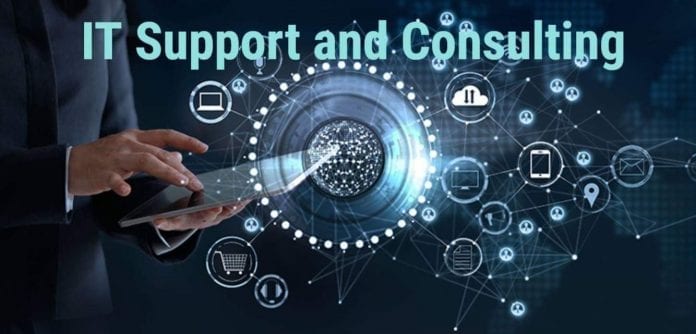With all the news streaming daily from tech hubs around the world, it’s sometimes hard to keep up with the myriad of big and small tech advances that rapidly infiltrate the global marketplace. For the average business, IT support often means simply keeping systems secure and hardware running seamlessly. That’s of course essential, but tech support can be the source of far more intuitive insights that go to the very heart of a successfully connected business.

With so many tech advances across various fields, it’s easy to go with the old playbook of rolling tech out to consumers as it benefits business. The intersection between people (customers) and technology (enabling consumer computing) has shifted, however. With the average global citizen online for hours every day, the move from self-perpetuating tech glory to consumer-driven technologies isn’t over.
While many might bemoan the impact of tech on the human experience, uptake and usage are still increasing. In a nutshell, whereas tech could simply be feted for being itself years ago, today’s commercial technologies – and their myriad support practitioners – need a far more nuanced, customer-centric touch, one that demonstrates an understanding of how exactly a company’s tech is experienced by the company’s clients. Savvy and comprehensive IT support outfits like EC-MSP factor in the human experience into everything they do.

The ultimate gauge has become (as it should always have been) not how new tech can trim a company’s costs, but rather how it can elevate the customers’ experience of a connected life and generate more profits. They might both point to the same outcome, but that result can stem from two entirely different points of departure. One is outdated and already costing companies who aren’t aware of how their digital organisation impacts their clients. The other is enabling, welcoming, and poised to serve the customer of the future. It’s the old tussle between efficiency and effectiveness – but in tech garb – and business leaders are still confusing the two.
Tech that makes business more efficient is great, but tech that makes business more effective makes customers like you, and there’s no better outcome than that for any company out there.
Tech is no longer unknown, and customers now define how they want to use it
The public has caught up: UX is not merely a preference or consideration anymore, it’s definitive to tech roll out. Although IT support appears to have a very linear mandate in which they are typically obliged simply to make things ‘work’ again, savvy companies lean on their IT technicians for a constant informal UX analysis (and implementation). According to CorpNetworking, many outsource IT support to professional companies and simply don’t deal with it. The modern connected consumer has become accustomed to ‘doing things’ a certain way – experiencing security protocols, for example, as a familiar construct – and generally carries high expectations.
Any company still developing tech-driven services and products along the old lines is not optimised for business today. Josh from totalityservices.co.uk tells us that mismatched expectations make the difference between the next Twitter, and just another wannabe that never happened. Customers expect a better and easier experience of life on the back of tech – no matter how flawed that might be as a blanket approach – and business is no exception. And not just retail consumers, but B2B service providers too need to demonstrate clear benefits and (preferably elevated) ease of use in their offering. Whereas the internet itself shone with a glow for a decade merely by existing, that’s not good enough anymore. Modern customers are savvy on the issues of connectivity, work pace and facilitation, and a line between those who place client experience at the forefront and those who don’t is now embedded in the marketplace.
Put more bluntly, if your tech is complicated or outdated, you’re losing customers whether you know it or not. To whatever extent tech informs modern business – and that extent is wholesale – UX has come to define a company’s effectiveness with its customers. Mismatched expectations are as important a tech issue to resolve as a better filing system or more intuitive intranet. The ‘tech-lash’ so often witnessed among diverse groups or people is not merely a primitivist backlash against tech per se, but more often a complaint against fraught ease of use, onerous system demands or a lack of transparency. The complaint is often not against the fact that tech now so completely dominates their lives, but rather that the entanglement is not going the way customers want it to go.
It might be seen as indicative of a renewed ‘me generation,’ but user dissatisfaction with a company’s technical presence is more often a legitimate complaint. Tech that clashes with consumer expectations is bad tech for business. For some IT support outfits UX is a prime USP, but all IT support has a far grander and encompassing feel for how tech plays out in the hands of consumers. Savvy companies will ask for that extrapolation, and implement the details as they’re identified.

Key inputs IT support should monitor going forward
Though they exist for a great many good reasons, closed ecosystems need careful integration when applied. Disjointed experiences alienate people, and there is no longer any acceptable gap between digital innovation and UX. Business has become wise to the fact that technical excellence means nothing if it doesn’t charm those carrying the cash. The modern business must deliver a demonstrably people-centric experience of their systems and offerings, or risk alienating customers. The best practice of yesterday is sometimes nothing but a millstone around a company’s neck today. Fast paced tech evolution worth monitoring is that which deals with the customer’s pleasure.
The robots are coming. As the robotic arena is progressing, manufacturing costs are diminishing, setting the stage for affordable mass production. The roll out of 5G is continuing apace and will aid robotic intelligence, too. Closely aligned – and for many consumers, inseparable from robots as a whole – AI will also need tactful application.
More on AI, as it has the potential to eliminate entire pillars of traditional business structures. Businesses willing to follow market indicators and reinvent the paradigm are those set to benefit most from AI. Consumers dislike background AI – artificial intelligence needs to identify and explain – and it’s likely that the IoT will define the layman’s easy understanding of intelligent things, setting a high bar for business employing AI, by implication. Non-threatening and transparent AI is what the global market will gravitate towards. Issues around privacy, security, and ethical application will need to be visibly addressed for hassle-free uptake.
From smartphones to smart things, the former world of companies making things as the end product of a process has forever diminished. Product ownership has changed – for example, smartphones are interactive and evolving items, not finished products on a fixed platform. A ‘co-ownership’ paradigm places a heavy burden on business to maintain performance, but also comes with a marketer’s dream attached – fulfil the expectations and enjoy a constant dialogue with customers.
Although clever analytics can steer marketing and ultimate uptake, consumers are wary of the surreptitious harvesting of their personal information. What being ‘customer focused’ really means is being honest. Ask for engagement, and demonstrate that you’re using it to customise their experience, and everyone is happy. Personal data and how it influences their digital experience is a hot point for consumers. Here, transparency is mandatory.
Keeping tech space with modern business – IT support is about elevating the human experience

Innovation has long been a popular term bandied about in business whether it was manifest or not. That has changed – innovation is ongoing, essential, and will likely define business longevity over the next decade or two. With so many technological advances poised to reshape the marketplace, only an innovative approach and application will ensure business currency.
Certain components are now critical in any business structure: the deft application of maturing digital technologies, DARQ technologies, and scientific expansion and advancement. Advances from nanotech might find application in commerce and industry, for example, while the natural sciences might give rise to a specific kind of algorithm never before considered by the IT fraternity. The pace of development and beneficial overlap is dizzying, but scientific discovery is a richer arena for business than ever before.
DARQ technologies are blockchain (distributed ledger technology), AI, Extended Reality (XR) and quantum computing. Intensely fertile areas of research, these technologies carry an innate potential to radically transform business as we know it. No one knows these new technologies like IT support, especially when it comes to their profitable application, likely snagging points, and ultimate success.
Rather than a linear upgrade over time, successful businesses of the immediate future will have a finger on the pulse of customer expectations and pain points. They will accept that transformation can come from diverse sources to either render an old way new again or completely eliminate legacy protocols and structures. And they will look for the new ideas and accompanying skills that further bolster the shiny UX that differentiates them in the market.









